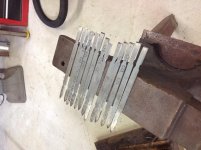View attachment 210478
Here's a pic of my Hay Budden on its stand, which is not as rusty as the photo makes it appear. The three legs are heavy-walled 1.5" X 3" tubing, the anvil rests on a 1" thick steel plate, which is 12" X 12" The legs are welded on at I believe a 22-degree angle, IIRC. The anvil's feet are cradled by sections of angle iron welded to the steel plate. The anvil is of course not welded, but is bedded in 3M 5200 marine adhesive, which holds in in place and also deadens the ring nicely. The adhesive is pretty strong, I can lift the anvil (136 lbs) and the stand comes up with it.
Two advantages of the stand are 1) a tripod lets me work close to the anvil from most angles, and 2) the heel of the anvil extends beyond the base plate, so that the pritchel and hardy holes are over the floor, not the stand. This let me use a certain style of holddown, although I rarely need it.
The bits resting on the anvil are partly-made potters' trim tools btw.




















